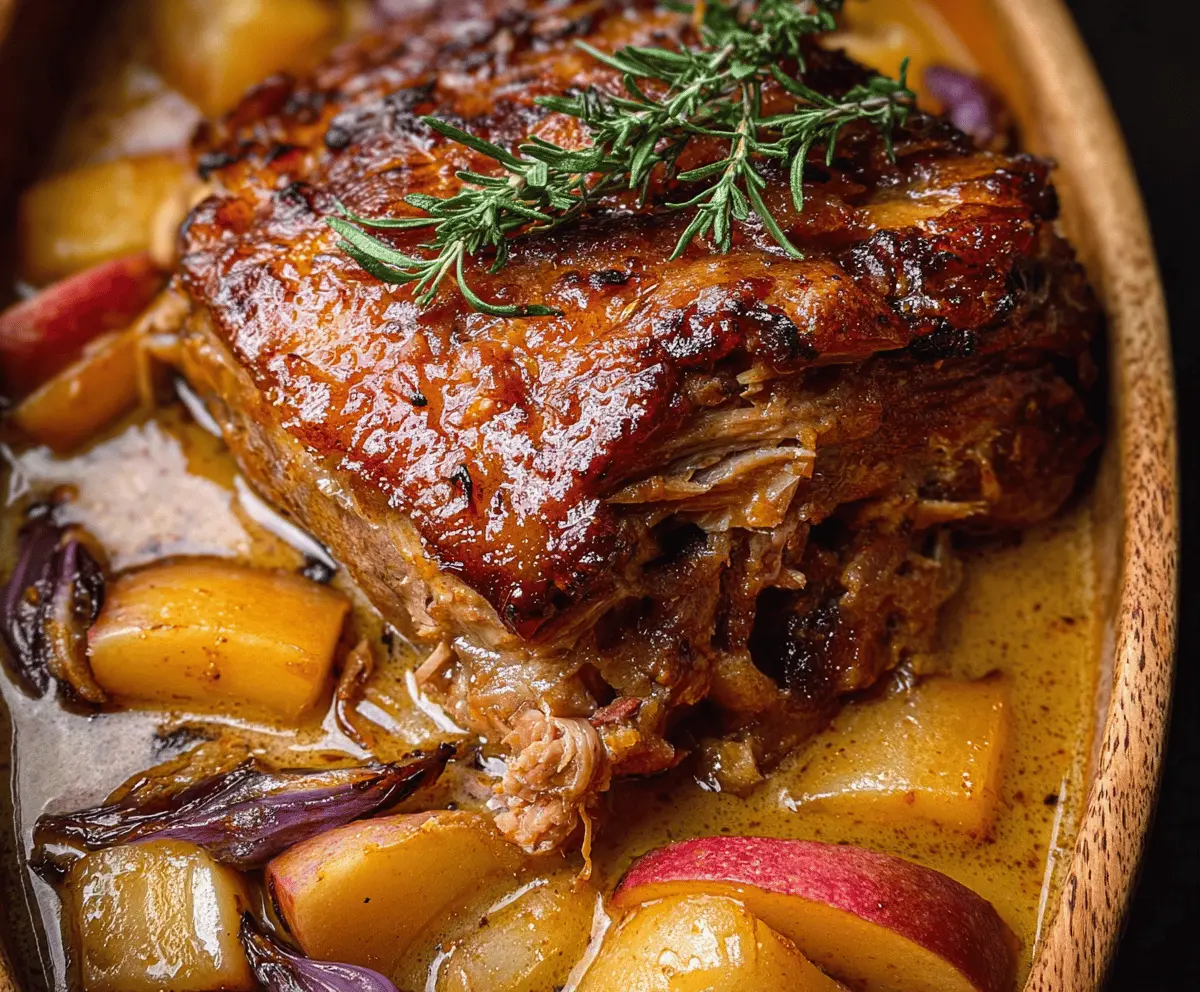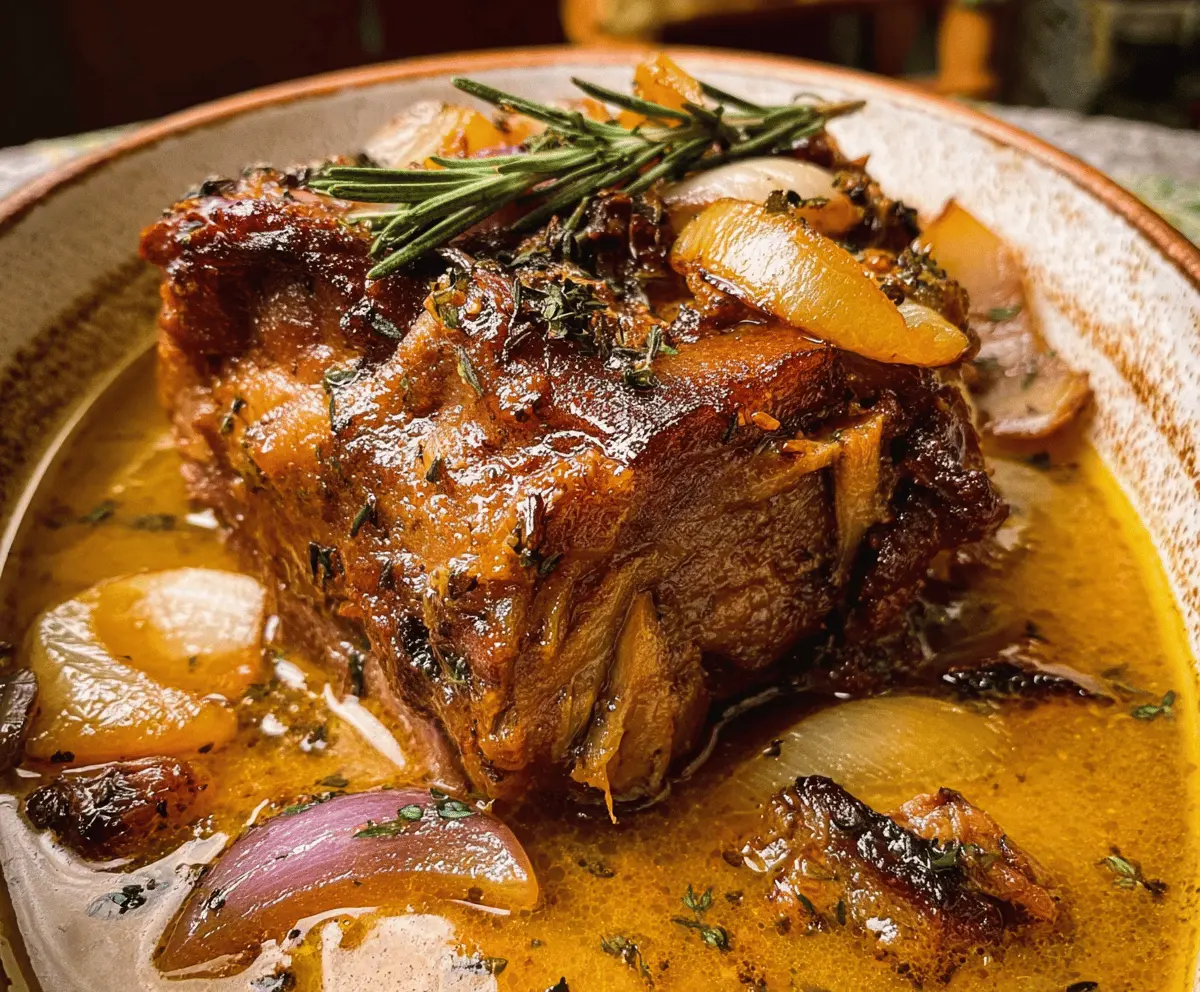Fall in a pot: this Apple Cider Braised Pork Shoulder is meltingly tender, deeply savory, and bathed in a glossy cider-onion gravy with hints of rosemary, garlic, and mustard. As it slow-braises, the pork becomes spoon-tender while the cider reduces into a balanced sauce—apple-fragrant but not sweet—perfect for ladling over mashed potatoes, buttered noodles, or creamy polenta. It’s the ultimate cozy centerpiece for Sunday supper, meal prep, or a casual dinner party.
Bone-in or boneless pork shoulder (a.k.a. Boston butt) is the ideal cut here; it loves a long, gentle cook and rewards you with succulent shreds and crackly-edged bits after a quick broil. Cider and stock keep things bright and savory, while a final splash of vinegar sharpens the flavors right before serving. The leftovers reheat beautifully—and the sandwiches might be even better the next day.
This method is as simple as it is impressive: sear, build a pan sauce with onions and cider, then braise low and slow until the meat yields to a fork. Hands-off magic with restaurant-level payoff.
Key Ingredients & Substitutions
Choose sturdy aromatics and a flavorful liquid so the braise finishes rich and balanced, not overly sweet.
Pork shoulder (4–5 lbs): Bone-in delivers extra flavor and moisture; boneless works and slices easily. Avoid lean cuts like loin—they’ll dry out.
Apple cider: Use unfiltered, unsweetened cider (not vinegar). In a pinch, mix apple juice with 1 tablespoon cider vinegar per cup to add tang.
Broth: Chicken or vegetable broth tempers the cider’s sweetness and adds body. Low-sodium lets you control seasoning.
Onions & garlic: The savory backbone. Add a carrot and a celery stalk for more classic braise flavor.
Dijon mustard: Cuts richness and deepens sauce complexity. Whole-grain mustard adds texture—use either.
Fresh herbs: Rosemary + thyme are ideal. Dried herbs work; reduce to 1 teaspoon each.
Acid finish: A spoon of apple cider vinegar or lemon juice at the end makes flavors pop.
Thickener (optional): A cornstarch slurry or a quick butter-flour knead (beurre manié) gives a silky, coat-the-spoon sauce.

Equipment You’ll Need
- Large Dutch oven (6–7 quarts) with lid
- Tongs and wooden spoon
- Instant-read thermometer
- Measuring cups and spoons
- Small bowl and whisk (for slurry, optional)
Flavor Variations & Add-Ins
- Maple-mustard: Add 1–2 tablespoons pure maple syrup and an extra teaspoon Dijon for a sweet-savory glaze.
How to Make Apple Cider Braised Pork Shoulder
Ingredients You’ll Need:
- 4–5 lb pork shoulder (bone-in preferred), excess fat trimmed
- 2 teaspoons kosher salt, plus more to taste
- 1 teaspoon black pepper
- 1 tablespoon smoked or sweet paprika
- 2 tablespoons olive oil
- 2 large yellow onions, thinly sliced
- 4 garlic cloves, minced
- 2 cups apple cider (unsweetened)
- 1 1/2 cups low-sodium chicken or vegetable broth
- 2 tablespoons Dijon mustard
- 2 sprigs fresh rosemary + 4 sprigs thyme (or 1 teaspoon each dried)
- 2 bay leaves
- 1 tablespoon apple cider vinegar or lemon juice (to finish)
- Optional thickener: 1 tablespoon cornstarch mixed with 1 tablespoon cold water
- Optional garnish: chopped parsley or chives
How Much Time Will You Need?
About 20 minutes to sear and build the braise, then 3–3½ hours at 325°F in the oven (or 6–8 hours on LOW in a slow cooker), plus 10 minutes to finish the sauce. Total: roughly 3½–4 hours, mostly hands-off.
Step-by-Step Instructions:
1. Season and sear
Pat the pork very dry. Mix salt, pepper, and paprika; rub all over. Heat olive oil in a large Dutch oven over medium-high until shimmering. Sear pork on all sides until deeply browned, 3–4 minutes per side. Transfer to a plate.
2. Build the flavor base
Reduce heat to medium. Add onions and a pinch of salt; cook, stirring and scraping up browned bits, until softened and golden at the edges, 6–8 minutes. Stir in garlic for 30 seconds.
3. Deglaze and assemble the braise
Pour in the cider and simmer 2 minutes, scraping up fond. Stir in broth and Dijon. Nestle pork (and any juices) back into the pot. Add rosemary, thyme, and bay leaves. Liquid should come about halfway up the pork—add a splash more broth if needed. Bring to a simmer.
4. Braise low and slow
Cover and transfer to a 325°F oven. Cook 2½ hours, then check: baste with juices, flip if desired, and continue 45–60 minutes more until the pork is fork-tender (195–205°F internal) and yields easily.
5. Optional crisp
For caramelized edges, transfer pork to a sheet pan and broil 3–5 minutes, watching closely, until lightly crisped. Rest 10 minutes, then shred or slice.
6. Finish the sauce
Skim excess fat from the braising liquid (or tilt and spoon off). Simmer on the stovetop 5–8 minutes to reduce slightly. For a silkier finish, whisk in the cornstarch slurry and simmer 1–2 minutes until glossy. Off heat, stir in cider vinegar or lemon juice and adjust salt and pepper.
7. Serve
Return pork to the pot or arrange on a platter. Spoon sauce over top and sprinkle with parsley. Serve with mashed potatoes, polenta, buttered noodles, roasted squash, or crusty bread.
Pro Tips for Best Texture & Taste
Small technique cues make a big difference in a slow braise.
- Dry = good sear: Pat the pork dry so it browns instead of steams; color equals flavor.
- Liquid height: Aim for liquid halfway up the meat. Too much dilutes flavor; too little risks drying before the collagen melts.
- Go by tenderness: Time is a guideline—pull when the shoulder shreds with gentle pressure.
- Brighten at the end: A teaspoon or two of acid (vinegar or lemon) lifts the sauce and balances the cider.
- Make-ahead bonus: Chill overnight; lift solidified fat, reheat gently, and the flavors will be even deeper.

Frequently Asked Questions
Can I make this in a slow cooker?
Yes. Sear the pork and sauté onions/garlic on the stovetop first (key for flavor). Transfer to a slow cooker with cider, broth, Dijon, and herbs. Cook on LOW 6–8 hours until tender. Reduce and finish the sauce in a saucepan if you want it thicker.
What if I only have apple juice?
Use apple juice and add 1 tablespoon cider vinegar per cup to mimic cider’s acidity. Taste the sauce at the end and adjust with another splash of vinegar if it’s leaning sweet.
Boneless vs. bone-in—does it matter?
Both work. Bone-in adds flavor and moisture; boneless slices neatly and often cooks a bit faster. Start checking boneless around the 3-hour mark.
How do I store and reheat?
Refrigerate up to 4 days or freeze (with sauce) up to 3 months. Reheat gently in a covered pot with a splash of broth or water until hot and tender.
Serving ideas?
Serve with mashed potatoes, Parmesan polenta, or egg noodles. For sandwiches, pile pork on toasted rolls with sharp cheddar and cider-onion gravy. Add a simple apple-cabbage slaw for crunch.


